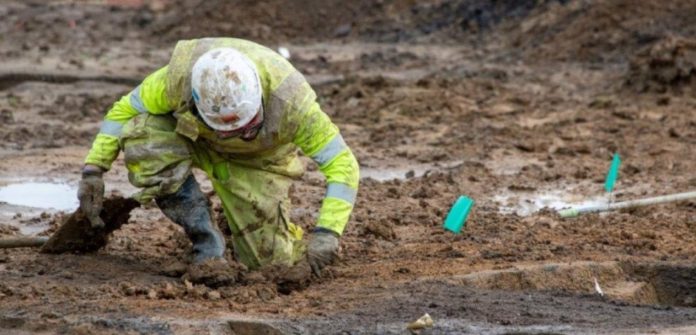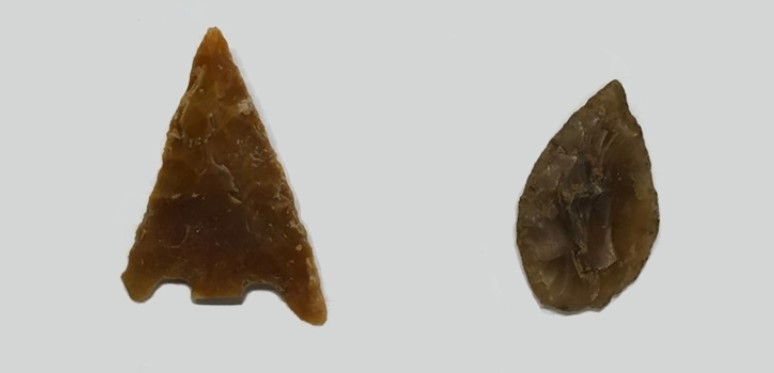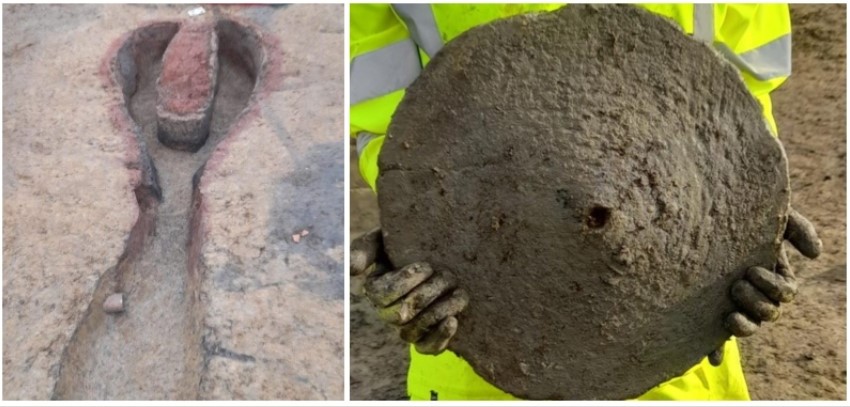Francesca Bologna : 24.01.2022 MOLA
MOLA Archaeologists have been busy digging with Cambridge Archaeological Unit as part of wider programme of archaeological work for the proposed National Highways A428 Black Cat to Caxton Gibbet Improvement Scheme.
At a site known as Field 44 near the village of Tempsford in Central Bedfordshire, the team uncovered an ancient farmstead. In use from the Middle Iron Age (c.300-100 BC) all the way through to the late Roman period (AD 201-400), this settlement offers an incredible opportunity to look at how life in the region changed over a long period of time.
From the start it was clear the site had lots of potential. The very first trial trenches dug in 2020 produced a surprising number of finds, including imported goods such as fine tableware (Samian) and amphorae (mainly used to transport liquids). These early excavations suggested that the site had a long and complex history, which is now being revealed.
EARLY LIFE AT FIELD 44
Well before the farmstead existed, people were already visiting this area. Although no evidence of where they lived has been found, they left behind signs of their activities. Flint arrow heads have been discovered dating back to the Neolithic (c. 4000-2200 BC) and Bronze Age (c. 2600-700 BC), suggesting that people were hunting wild animals in the surrounding landscape.
THE FIRST COMMUNITIES
It is in the Middle Iron Age (c.300-100 BC) that we find the first evidence of a settlement. Two large roundhouses can be dated to this period. They are more than 15 metres wide, which is bigger than most other examples from this time. The remains of butchered animals, pottery, loom weights and even personal dress items (such as a ring headed pin) were found within these buildings. This shows that people both lived and worked inside them. Most features dating to the Middle Iron Age survive best in the southern part of the site, as this was only used for a relatively short time. Elsewhere, they were built upon or destroyed by later structures as the layout of the site changed. It is likely that this early settlement was surrounded by a boundary. Yet, the first clear traces of ditches, arranged in a D shape, date to the Late Iron Age (c.100 BC-AD 43).
THE ROMAN INVASION
After the Roman Conquest in AD 43 the settlement expanded and continued to be occupied for around 400 years. At the time, farming was an important activity at Field 44. This is proved by the discovery of an oven used to dry grains and make malt for brewing, as well as by the querns (simple hand mills for grinding grains) and cereals found on site.
However, this was also a place where goods were being produced and traded. Archaeologists have identified a Roman pottery kiln with a vast number of wasters (pots which failed during the firing process). Moreover, a number of higher status small finds have also been uncovered, beyond what is expected of a typical farmstead in this part of the country. Together these discoveries show the growing wealth and importance of the settlement.
As excavations continue and finds specialists begin to analyse artefacts in more detail, more will be revealed about the site and those who lived there. The story of Field 44 is only just beginning.
JOIN THEM ON THE JOURNEY!
- @A428Cat
- Facebook.com/A428BlackCat
- #A428BlackCat
- Find out more about the A428 National Highways scheme
Excavations at Field 44 are being undertaken by archaeologists from MOLA and Cambridge Archaeological Unit, as part of the proposed National Highways A428 Black Cat to Caxton Gibbet Improvement Scheme managed by Skanska.
From From flint arrow heads to Roman kilns – centuries of history at Field 44 on the A428 | MOLA



